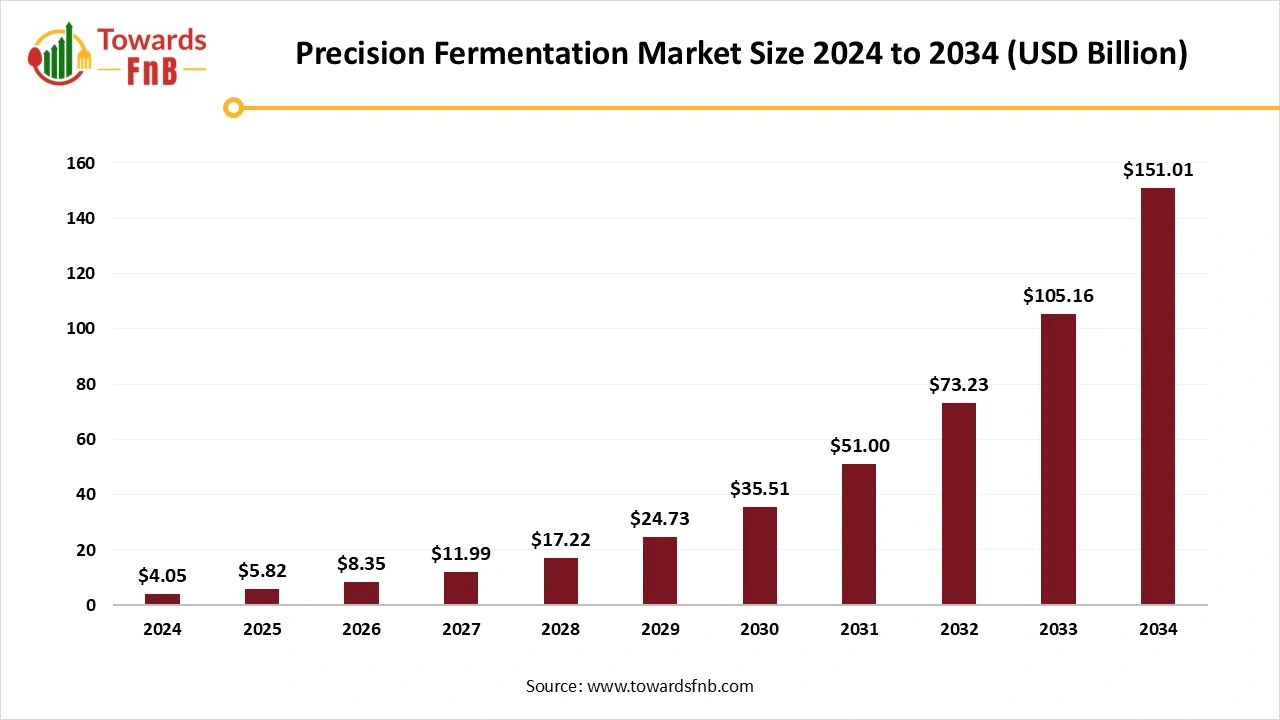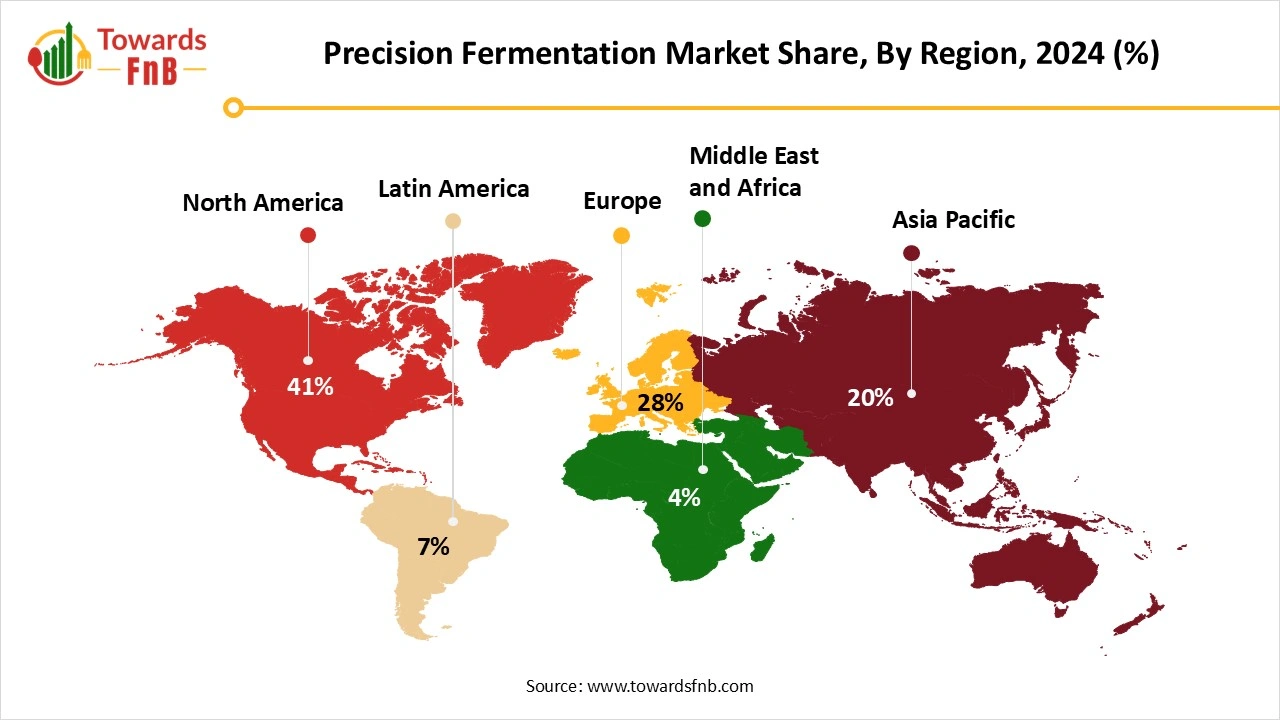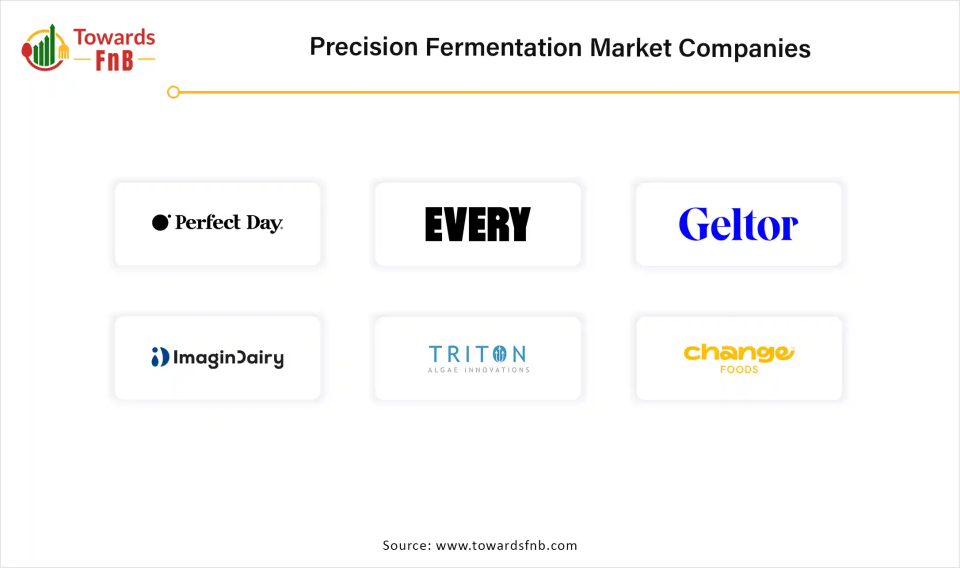December 2025
The global precision fermentation market size calculated at USD 4.05 billion in 2024 with projections indicating a rise from USD 5.82 billion in 2025 to approximately USD 151.01 billion by 2034, expanding at a CAGR of 43.6% throughout the forecast period from 2025 to 2034. Growing demand for the sustainable and alternative protein significantly driving the market.

| Study Coverage | Details |
| Growth Rate from 2025 to 2034 | CAGR of 43.6% |
| Market Size in 2025 | USD 5.82 Billion |
| Market Size in 2026 | USD 8.35 Billion |
| Market Size by 2034 | USD 151.01 Billion |
| Largest Market | North America |
| Base Year | 2024 |
| Forecast Period | 2025 to 2034 |
| Regions Covered | North America, Europe, Asia-Pacific, Latin America, and Middle East & Africa |
The precision fermentation market involves the use of genetically engineered microbes (like yeast, bacteria, or fungi) to produce specific functional ingredients such as proteins, enzymes, fats, and vitamins with high purity, efficiency, and sustainability. Unlike traditional fermentation, precision fermentation leverages synthetic biology and biotechnology to replicate animal or plant-based compounds without needing the original source. It is a game-changing platform technology for industries such as alternative proteins, dairy, food ingredients, cosmetics, and pharmaceuticals, enabling a shift toward sustainable, cruelty-free, and resource-efficient production systems.
Precision fermentation is revealing transformative potentials in biotechnology, consumer products, and sophisticated manufacturing. Businesses in various industries are embracing this technology to develop advanced, high-performance materials free from the limitations of traditional manufacturing methods. Personalization and innovation are additional significant advantages of precision fermentation. It allows for the creation of distinct food items designed to meet particular consumer desires and requirements. For example, businesses can produce lactose-free dairy substitutes with similar protein compositions to cow's milk, nutritious fats and oils that mimic the taste of animal fat, or custom sweeteners that imitate the flavor intensity of sucrose.
This degree of innovation creates new market prospects and addresses the changing needs of contemporary consumers. Components usually present in intricate blends can now be generated separately and reassembled innovatively to produce new food items and expand protein options. For example, Impossible Foods Inc utilizes PF to create soy leghaemoglobin, which can be included as an ingredient in plant-based burgers to better replicate the look and flavor of meat-based burgers.
Even with its potential, the precision fermentation market encounters numerous obstacles, especially related to elevated production expenses. Building and expanding fermentation plants requires substantial investment, which restricts entry for smaller competitors. Furthermore, operational costs continue to be high because of the energy-heavy characteristics of microbial processes and strict quality control standards.
North America Dominated the Precision Fermentation Market in 2024.
This dominance arises from the region’s sophisticated technological framework, significant funding in biotech and food tech research and development, and a favorable regulatory landscape that encourages advancement in food technologies. The growing surge of consumer awareness is sending ripples through the market, generating waves of desire for precision fermentation products. As consumers grow more aware of the links between climate change, health, and ethical decisions, they’re seeking out these sustainable options, encouraging industries to change their course and head toward environmentally friendly destinations. Market innovators are leveraging this technology to create dairy alternatives, like vegan yogurt and cheese, that replicate the beloved textures and flavors consumers enjoy, all while respecting dietary preferences and food restrictions.

The U.S. Precision Fermentation Market is undergoing a significant change fueled by an increasing need for sustainable food production and alternative protein options. Consumers in the US are progressively looking for products that are both eco-friendly and ethically manufactured. This shift in consumer habits is driving innovation in the marketplace, as firms seek to create precision fermentation technologies that can effectively generate proteins via microbial fermentation. In the United States, the FDA holds regulatory power over foods derived from precision fermentation. The FDA concentrates on safeguarding the safety of food and food components, including those created via precision fermentation, frequently utilizing genetically modified microorganisms.
Asia Pacific Expects Significant Growth During the Forecast Period.
Urbanization, a rising need for sustainable food options, and governmental backing for alternative proteins are among the reasons why Asia Pacific stands out as a premier market for precision fermentation ingredients. The substantial increase in food-tech and biotech investments in the Asia Pacific region is primarily driven by significant funding in precision fermentation across major economies like China, India, Japan, and Singapore. India, China, and South Korea are adopting advancements in fermentation technologies that enable the mass production of components sourced from microorganisms.
A key factor propelling the precision fermentation market in India is the rising demand for alternative proteins. As worries grow regarding the environmental effects of conventional animal agriculture and the demand for more sustainable food production methods, precision fermentation presents an encouraging alternative. It enables the creation of plant-derived and lab-cultivated proteins that replicate the flavor, texture, and nutritional characteristics of animal-derived products, all while reducing the environmental impact. This is especially attractive to India, where the vegetarian and vegan food market is significant, and the transition to more sustainable protein options is increasing in popularity.
Why did the Protein Segment Dominated the Precision Fermentation Market in 2024?
Proteins (casein, whey, albumin) segment dominated the precision fermentation market in 2024. Market expansion is fueled by the rising acceptance of plant-based and vegan diets, heightened awareness of gut health, and increasing investments in alternative proteins. Fermentation enhances the bioavailability of proteins, thereby expanding their use in food and beverages, dietary supplements, and functional nutrition items. Additionally, enhanced microbial fermentation methods and precision fermentation enable the creation of premium, bioavailable protein components. Whey and casein proteins are highly esteemed for their exceptional protein quality, digestibility, and balanced amino acid compositions.
Fats & Oils Segment is Observed to Grow at the Fastest Rate During the Forecast Period.
Consumers are progressively looking for substitutes to conventional animal fats, boosting the need for precision fermentation-based fats that can mimic the flavor and performance of animal fats in plant-based products. With consumers looking for plant-based and sustainable options to replace animal fats, precision fermentation allows for the creation of fats with tailored nutritional compositions and flavor characteristics.
Which Microorganism Type Dominated the Precision Fermentation Market in 2024?
Yeast segment held the dominating share of the precision fermentation market in 2024, due to its well-established use in producing a wide range of functional ingredients such as proteins, enzymes, and vitamins. The simplicity of genetic alteration, impressive output, and ability of yeast to grow on inexpensive substrates make it a preferred host organism for commercial production. Yeast plays a crucial role in generating animal-free proteins such as whey and egg white, which are highly sought after for plant-based and alternative protein products.
Genetically Modified Bacteria Segment is Seen to Grow at a Notable Rate During the Predicted Timeframe.
The use of genetically modified bacteria in food manufacturing is changing the food sector, improving efficiency and sustainability via cutting-edge fermentation methods. They are also very receptive to genetic alteration, allowing scientists to accurately construct bacterial strains to generate proteins, enzymes, or other important substances with great efficacy and purity.
How did the Dairy Alternatives Segment Hold the Largest Share of the Precision Fermentation Market in 2024?
Dairy alternatives segment held the largest share of the market in 2024. This growth is fueled by a higher demand for plant-based diets, the global rise in lactose intolerance, and changing consumer preferences for sustainable and ethical food options. Precision fermentation enables the creation of dairy proteins such as whey and casein that are molecularly identical to those sourced from cows, providing a more sustainable and animal welfare-focused alternative to conventional dairy. This technology allows for the development of dairy-free products that have enhanced flavor, texture, and nutritional benefits over conventional plant-based options.
Meat & Egg Alternatives Segment is Expected to Grow at the Fastest Rate in the Market During the Forecast Period.
With a growing focus on health, environmental sustainability, and ethical considerations, consumer interest in plant-based diets is increasing, making the market increasingly significant. As worries increase regarding animal welfare and the environmental effects of livestock agriculture, vegan options are regarded as a sustainable answer. Fueled by advancements in biotechnology, meat alternatives that utilize fermentation are quickly developing and expanding. Fermentation technology currently presents a more effective and sustainable way to produce meat alternatives on a large scale, serving as a viable substitute for resource-heavy and ecologically harmful livestock farming.
Why did the Food & Beverage Manufacturers Segment Dominate the Precision Fermentation Market In 2024?
Food & beverage manufacturers segment held the largest share of the market in 2024. Fermented foods and drinks have been linked to numerous beneficial health outcomes, such as enhanced digestive health, increased immunity, and better nutrient absorption. Fermented products can be present in numerous foods and beverages, including bread, beer, yogurt, and cheese. Fermented amino acids are widely used in food items, and various amino acids offer distinct flavors to the food products they are incorporated into. Precision fermentation enables the creation of different ingredients, such as fats, proteins, and flavor compounds, providing options for meat and dairy substitutes, along with functional and nutritional improvements in traditional food items.
Cosmetics & Personal care Brands Segment is Observed to Grow at the Fastest Rate During the Forecast Period.
The cosmetic sector is a swiftly expanding field that has faced challenges in recent years concerning the source and effects of its ingredients and production methods. In an effort to lower carbon dioxide emissions and enhance product degradability, many traditional ingredients are being abandoned to comply with stricter regulations and consumer ethical expectations. Biotechnology, with fermentation as its fundamental technology, offers a solution to promote and encourage more sustainable development in the cosmetic sector. Precision fermentation can be applied to create components for personal care items, including cosmetics, skincare products, and fragrances. Microorganisms can be modified to generate specialized components, including collagen, hyaluronic acid, and enzymes, utilized in different cosmetic products, providing eco-friendly and cruelty-free options compared to conventional sources.
21st.BIO
Food Standards Agency
Roelmi Biotech

By Product Type
By Microorganism Type
By Application
By End-User
By Region
December 2025
December 2025
December 2025
December 2025